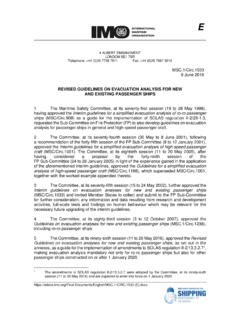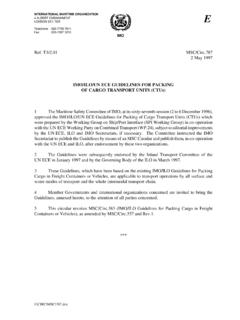Transcription of GUIDELINES FOR MAINTENANCE AND …
1 INTERNATIONAL MARITIME ORGANIZATION. 4 albert embankment . london SE1 7SR E. telephone : 020 7735 7611. Fax: 020 7587 3210. Telex: 23588 IMOLDN G IMO. Ref. T3 28 May 2002. GUIDELINES FOR MAINTENANCE AND MONITORING OF ON-BOARD. MATERIALS CONTAINING ASBESTOS. 1 The Maritime Safety Committee, at its seventy-fifth session (15 to 24 May 2002), approved GUIDELINES for MAINTENANCE and monitoring of on-board materials containing asbestos, as set out in the annex. 2 The GUIDELINES are intended to provide guidance to Administrations, companies, seafarers and others closely involved with the operation of ships on how to deal with asbestos on board ships in service, with the principal objective of minimising exposure to asbestos fibres of passengers, crew, riding crews, MAINTENANCE personnel in port, etc.
2 , while the ship is in service. 3 Member Governments are invited to use the annexed GUIDELINES when dealing with asbestos on board ships in service. Member Governments are also invited to bring the GUIDELINES to the attention of all parties concerned, in particular companies, seafarers, ship operators and ship repairers. **. I:\CIRC\MSC\ ANNEX. GUIDELINES FOR MAINTENANCE AND MONITORING OF ON-BOARD. MATERIALS CONTAINING ASBESTOS. 1 Introduction These GUIDELINES aim at providing guidance to Administrations, companies as defined in SOLAS regulation IX/1, seafarers and others closely involved with the operation of ships on how to deal with asbestos on board ships in service.
3 They do not intend to address other aspects of asbestos that are already covered by the work of other international organizations (contact details of the International Labour Office (ILO) and the World Health Organization (WHO) are indicated in annex 2). 2 Scope of application These GUIDELINES do not apply to ships which have asbestos aboard as allowed by SOLAS. regulations II-1 , and The purpose of the GUIDELINES is to set up a MAINTENANCE and monitoring programme with the principal objective of minimising exposure to asbestos fibres of anyone on board (passengers, crew, riding crews, MAINTENANCE personnel in port) while the ship is in service ( , as opposed to when the ship is in a repair or dry-dock status with minimal crew members or only shore-side personnel on board).
4 The present GUIDELINES address the following three situations: .1 general exposure of crew/passengers to asbestos which may be present on the ship;..2 more direct exposure of crew members working in areas where there is reasonable likelihood that asbestos is or asbestos fibres are present; and .3 specific exposure of crewmembers and other workers when they are maintaining or repairing equipment or systems known to contain asbestos-based insulated materials. Planned repairs or removal of such materials should be carried out by specialist personnel and not normally by crew. In cases where the crew is involved in urgent repair work at sea, special measures should be observed as listed in annex 1.
5 Procedures should be developed for the safe retention of any waste asbestos on board the ship before it can be transferred and disposed of ashore. The provisions of these GUIDELINES do not apply to any warship, naval auxiliary or other ships owned or operated by a State and used, for the time being, only on government non-commercial service. However, each State should ensure, through the adoption of appropriate measures not impairing operations or operational capabilities of such ships owned or operated by it, that such ships act in a manner consistent, so far as is reasonable and practicable, with these GUIDELINES .
6 I:\CIRC\MSC\ ANNEX. Page 2. 3 General provision The Company should make provisions, including the nomination of a responsible person to control the MAINTENANCE and monitoring program for asbestos, in their Safety Management System (developed for compliance with the ISM Code) for the MAINTENANCE and monitoring of on board materials containing asbestos in line with the provisions of the present GUIDELINES . 4 Inventory and condition assessment of asbestos-containing materials The Company should have an initial ship inspection performed by a qualified professional to investigate the possible presence of asbestos-containing materials on board the ship and, if any are identified, to locate them and assess their condition.
7 The inspection should serve as the basis for establishing an effective MAINTENANCE and monitoring programme for dealing with the asbestos in the ship. In the case of flake coatings, lagging or false ceilings containing asbestos, their condition should be assessed by completing the evaluation checklist shown in appendix 1 to annex 1, which takes into account, in particular, the accessibility of the materials and products, their degree of degradation, their exposure to shocks and vibration and the presence of air currents in the area. Air sampling of dust measurement may be used as one tool to help provide a more complete assessment of the ambient conditions on board.
8 The evaluation form contained in appendix 2 to annex 1 should be used to make the diagnosis on the state of conservation of these materials. 5 MAINTENANCE and monitoring programme If asbestos-containing material is located, a MAINTENANCE and monitoring programme should be developed for that ship, based on the inspection and assessment data. The programme should be implemented and managed conscientiously and include the elements contained in annex 1. In the case of flake coatings, lagging or false ceilings containing asbestos, depending on the diagnosis as described in paragraph , the company should establish appropriate thresholds and timescales for undertaking any necessary repairs or abatement, taking into account any national regulations.
9 6 Abatement actions, planned repair and removal of asbestos-containing materials Abatement actions should be selected and implemented when necessary. In some instances, due to the condition of asbestos-containing materials or upcoming ship repairs or modifications, a Company may decide to take other abatement actions to deal with asbestos-containing materials in the ship. These response actions could include: encapsulation (covering the asbestos-containing materials with a sealant to prevent fibre release), enclosure (placing an air-tight barrier around the asbestos-containing materials), encasement (covering the asbestos-containing materials with a hard-setting sealing material) or repair or removal of the asbestos-containing materials.
10 Qualified, trained and experienced contractors should be used for any of these actions. The Company should be aware of any national and local regulations that pertain to abatement actions to deal with asbestos-containing materials. I:\CIRC\MSC\ ANNEX. Page 3. In the event of works requiring the removal of asbestos-containing materials, they should be unloaded from the ship. On completion of the work, and before any restoration of the spaces, the Company should carry out dust measurement after dismantling the enclosing mechanism. If the work does not result in the total removal of the materials and products listed in this order, the Company should carry out regular surveillance of the asbestos-containing materials at intervals identified by the Company as being appropriate, but not exceeding 3 years.













